Accidental Rules #7 – Writing Notes using Accidentals and Key Signatures
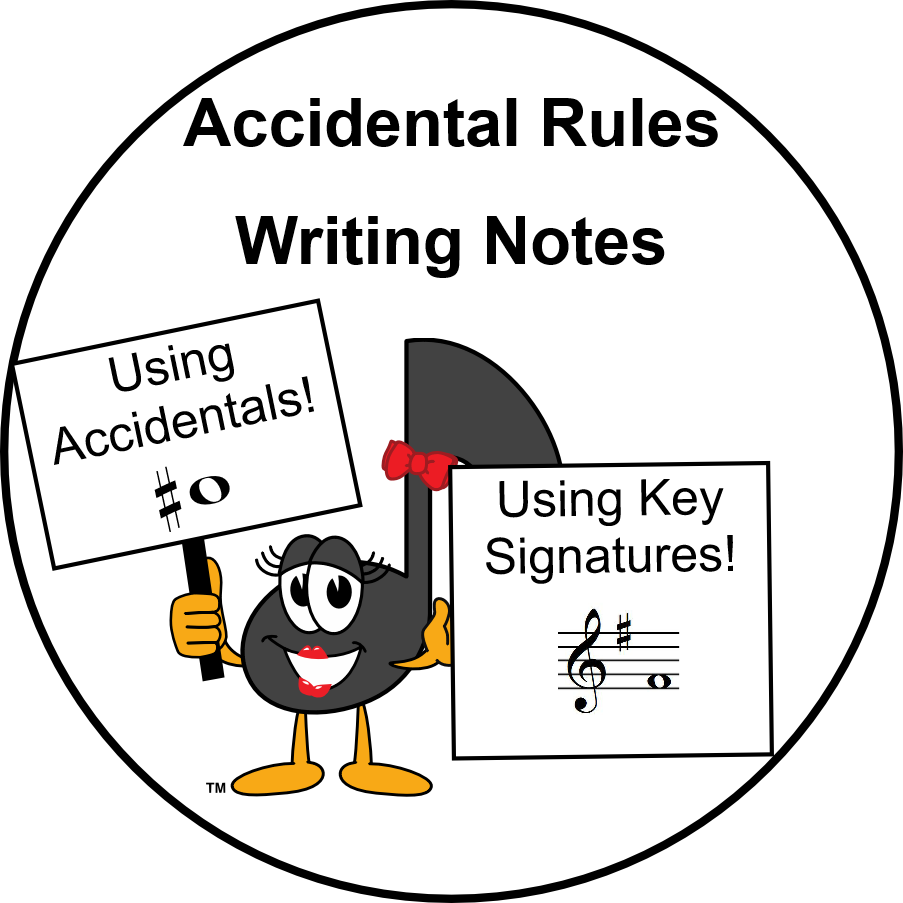
When writing notes, we have to observe the accidentals in the Key Signature and the accidentals in the Music.
Accidentals in the Key Signature apply to any note with that letter name, either on the Staff or on Ledger Lines. Accidentals in the Key Signature can be changed temporarily by another Accidental and are canceled by a Bar Line.
Accidentals in the Music apply to any note on that line or in that space until it is canceled by another Accidental or by a Bar Line.
Writing notes using Accidentals and Key Signatures is actually harder than it looks. There will also often be more than one correct answer! *sigh*
Accidental Rules - Adding Necessary Accidentals
Before we start with the Pop Quiz, it is important to review what we know. We learned the following in:
Accidental Rules #1 Natural Rules, we reviewed How, When and Where to write the Natural Sign.
Accidental Rules #2 Naming Notes, we reviewed how accidentals affect the name of the note.
Accidental Rules #3 Writing Accidentals, we reviewed how to teach Students to write accidentals using the KISS Method.
Accidental Rules #4 Tied Notes with Accidentals, we reviewed how to name/identify notes when they are tied (and how the tie and bar line affect the accidental).
Accidental Rules #5 Accidental Rules - Adding Necessary Accidentals, we learned the rules required to add Accidentals in music.
Accidental Rules #6 Accidental Rules - Accidentals and Key Signatures, we learned the difference between an Accidental found in the Key Signature and an Accidental found in the music.
In this final blog in my Accidental Rules #7 in this Series, we are going to learn how to write the notes when we are given the letter names (the note names).
Let's have fun and start with a Pop Quiz. Read the instructions carefully. In the Ultimate Music Theory Certification Course Basic Examination, this question is one that many Teachers struggle with. Once they understand the rules, they "get it". Are you 100% positive of your answers? Are your answers the only correct answers?
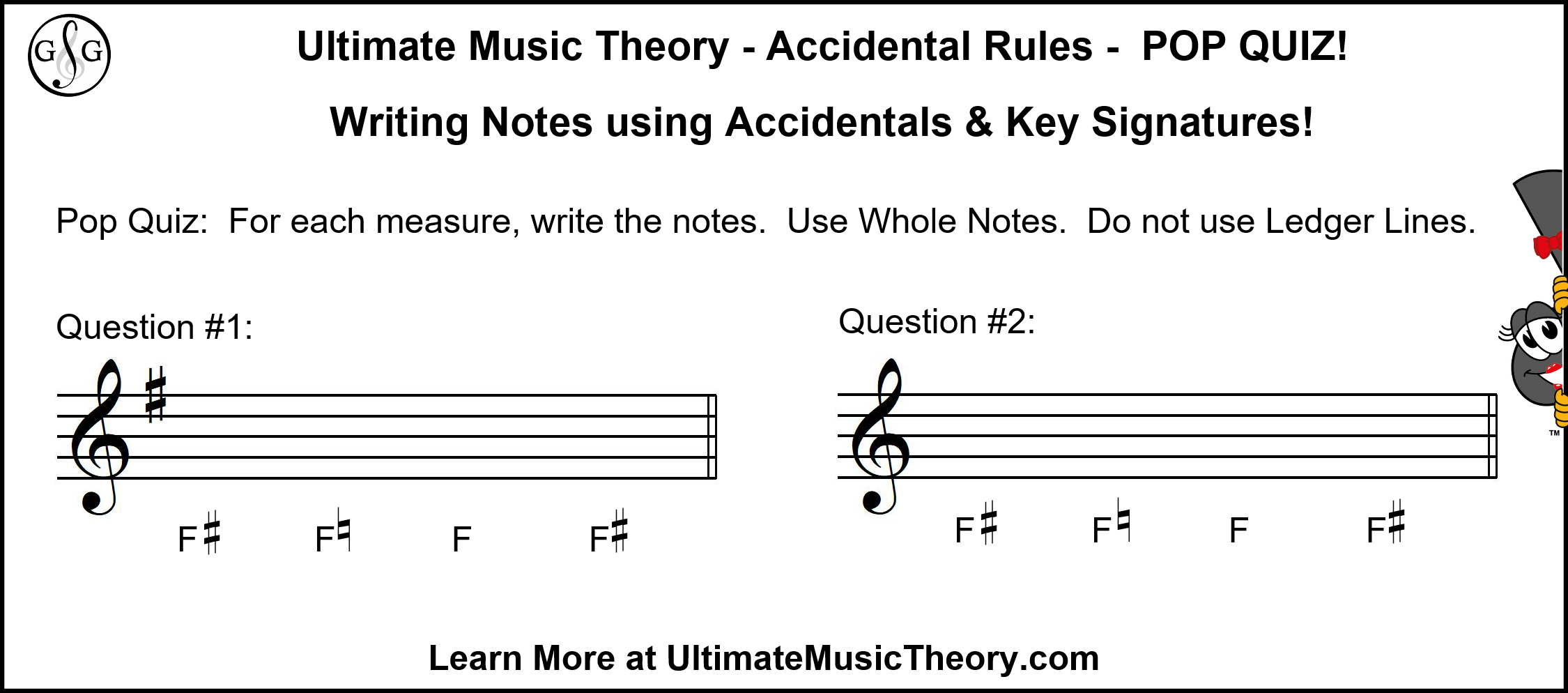
Before we look at the Correct Answers, I would like to explore the common mistakes that I see as an Examiner and as a Teacher. When we "Spot the Boo-Boo", we actually learn and review what we know.
Accidental Rules - Writing Notes - Question #1 - Spot the Boo-Boo - Incorrect Answer #1
Before you read my notes on each note, can you identify the errors in this possible answer?
Note #1: This note is incorrect. The F Sharp in the Key Signature makes every F "sharp", whether it is on Line #5 (where the F Sharp is written in the Key Signature in the Treble Staff), or whether it is written in Space #1, or on 7 Ledger Lines above the Treble Staff.
The accidental sharp before the Note #1 F is not necessary as the sharp already appears in the Key Signature.
Note #2: This note is correct. The natural sign is temporarily cancelling the Key Signature F Sharp. Remember the Natural Rule - when we SEE the natural, we SAY the natural. We "see" the natural sign after the letter name F, therefore we must write the natural sign ("say" the natural) before the note on the staff.
Note #3: This note is incorrect, and this concept is where many Teachers get confused. There is NO natural sign after the letter name. The letter name asks you to write simply "F". Therefore, the natural sign on space #1 is redundant. The F was made natural in Note #2. Any F in space #1 after that natural sign is going to be "F" (unless another accidental is written, and until the Bar Line cancels the natural sign).
Note #4: This note is incorrect. The sharp is not required before the note on Line #5. The sharp is in the Key Signature.
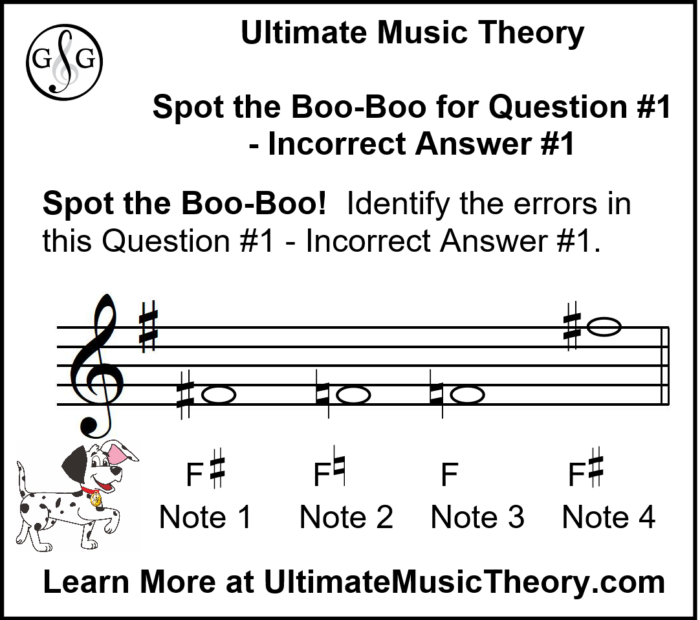
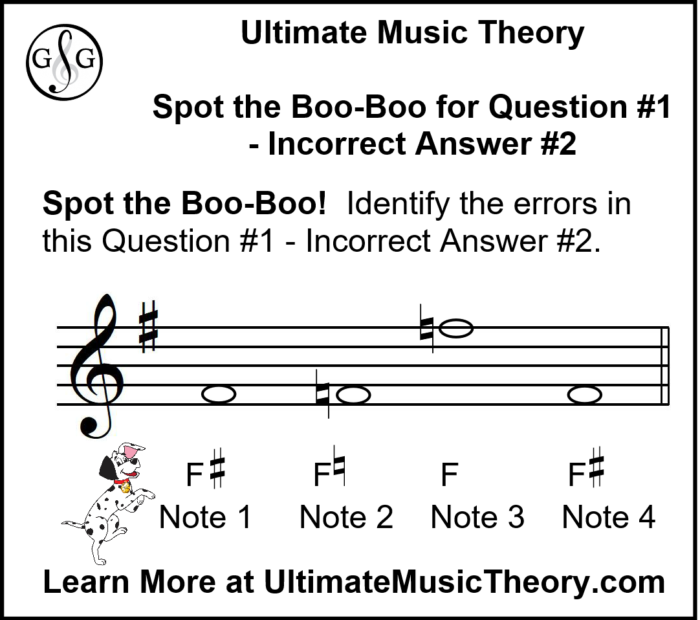
Accidental Rules - Writing Notes - Question #1 - Spot the Boo-Boo - Incorrect Answer #2
Here we have another possible answer for Question #1. Can you Spot the Boo-Boos in this example?
Note #1: This note is correct.
Note #2: This note is correct. (We "See" the Natural Sign, so we "Say" the Natural Sign.)
Note #3: Oops. Again, this is another common error on the Basic Exam for Teachers in the Certification Course. The requested note is simply F. It is not F sharp. If you write a natural sign in front of the note, it becomes F natural. That is a different written note. (F and F natural may sound like the same note when you play them. But do you understand why they are not the same when you write them?)
With the Natural before Note #2 in space #1, the only place that we can write an "F" is in space #1. Any other place would require a natural sign to cancel the Key Signature F Sharp. Since there is no word "natural" after the letter name "F", we cannot use a natural sign to write the note F.
Note #4: This is incorrect. The natural on Note #2 has temporarily cancelled that Key Signature sharp. For the F on Space #1 to be an F Sharp, then we would need to write the sharp sign before Note #4.
I have shown you 2 possible Incorrect Answers for Question #1. Are you ready to see the Correct Answer for Question #1?
Well, I cannot show you a Correct Answer. I can show you SIX Possible Correct Answers! Does your Answer to Question #1 match any of these Six Possible Correct Answers? Are there any other possible Correct Answers?
Remember the instructions said "Do not use Ledger Lines". Did you use any?
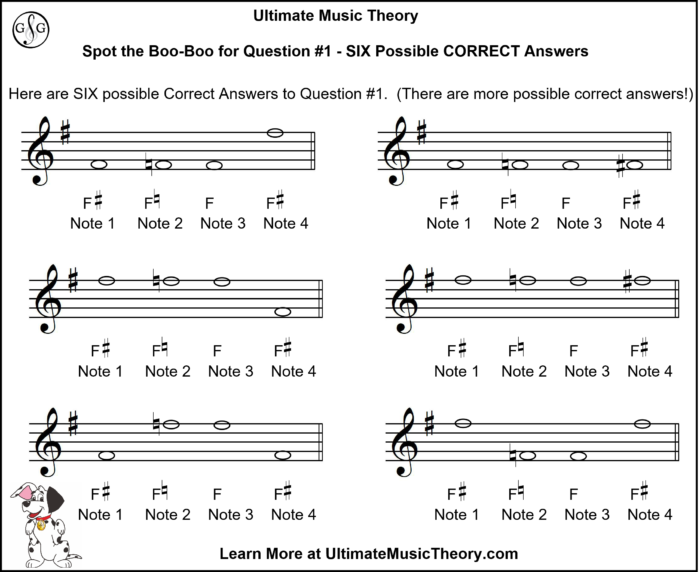
Accidental Rules - Writing Notes - Question #2 - Spot the Boo-Boo
Let's look at your answer to Question #2. Did you notice that there is no Key Signature in this question? Did you use any Ledger Lines? If you did, each note on a Ledger Line is automatically incorrect. Why? Because the instructions clearly state "Do not use Ledger Lines.". If your Student writes any of these notes using a Ledger Line - even if the note is "correct" - the ANSWER is marked as incorrect. Students must learn how to follow the instructions. Partial correct marks are not given if the actual instructions have been ignored.
Now, here are 2 possible Incorrect Answers for Question #2. Before reading my Notes, can you explain what is correct and what is incorrect?
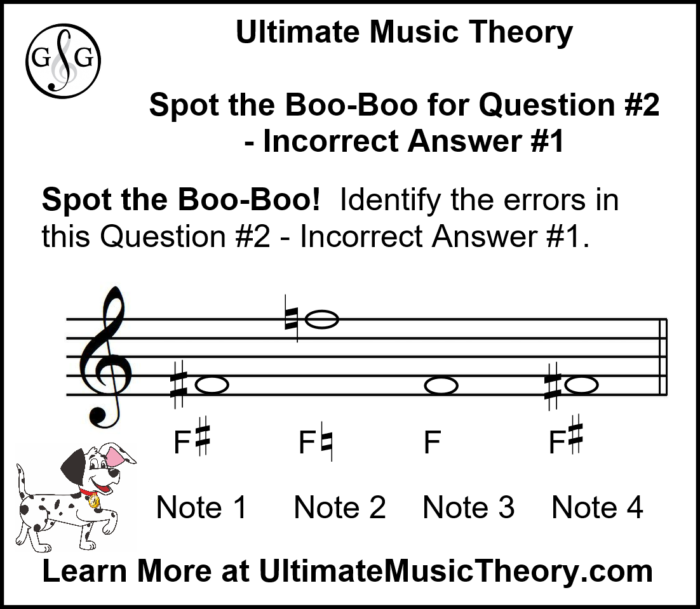
Accidental Rules - Writing Notes - Question #2 - Spot the Boo-Boo - Incorrect Answer #1
Note #1: This note is correct.
Note #2: This note is incorrect. Yes, we have the natural sign written in front of the note, so we are following the rule "See the Natural, Say the Natural". However, what is that natural cancelling?
The accidental sharp sign is written on the F in Space #1. Thus, the only place that we can use a natural to write an F natural is if we write it in Space #1 too. (If the accidental sharp sign was written on the F on Line #5, the only place that the F natural would be correct is if we write it on Line #5 too.)
Note #3: This note is incorrect. Since there is still an active F sharp in Space #1 (it has not been cancelled by another accidental or by a Bar Line), then Note #3 - the F in Space #1 - is still sharp.
Note #4: This note is incorrect too. Yes, when we play Note #4, we play the F sharp. However, writing a sharp before Note #4 is redundant. The sharp is already there in Space #1.
Accidental Rules - Writing Notes - Question #2 - Spot the Boo-Boo - Incorrect Answer #2
Note #1: This note is correct.
Note #2: This note is incorrect. Remember, F and F natural are written differently. When we write F natural, we need to use a natural sign on the staff.
Also, the sharp for Note #1 only affects the notes on Line #5 (until canceled by another Accidental or by a Bar Line). The sharp does not affect the F in Space #1.
Since we want an F natural, we must write the note on the same line (Line #5) where the Sharp previously appeared in that measure. This gives us a reason to use the Natural Sign.
Remember that a "Redundant Natural Sign" is a natural sign that is written when it is not necessary.
Note #3: This note is correct.
Note #4: This note is incorrect. The only sharp sign is written on Line #5. When we write an F sharp in Space #1, we need to actually write the sharp before the whole note in Space #1.
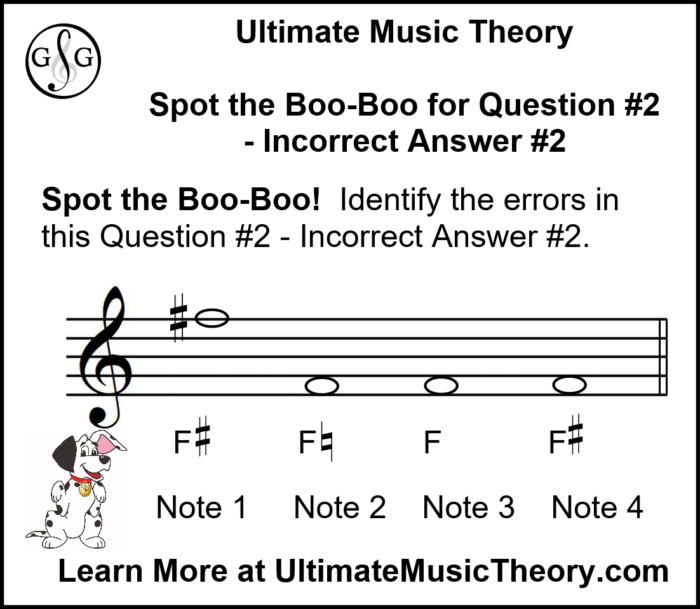
So what is the correct answer for Question #2? Again, there is more than one correct answer. Here are Four Possible Correct Answers. Does your answer match any of these? Or do you have another possible correct answer?
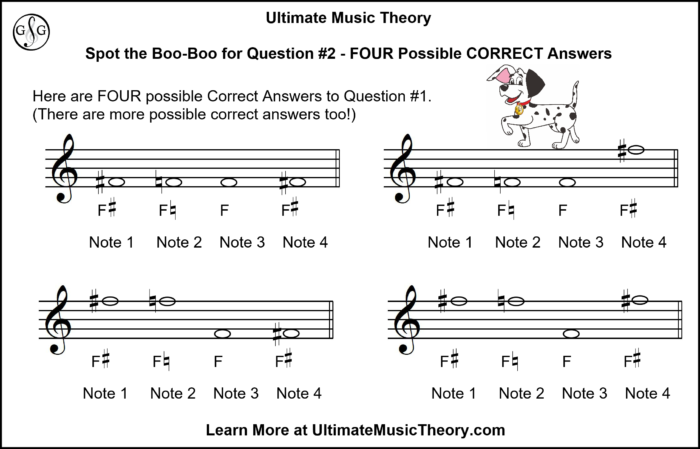
Accidental Rules - Writing Notes using Accidentals and Key Signatures - Worksheets (For Members Only!)
Have you checked out the Ultimate Music Theory Membership yet? As part of your Membership, you will be able to print two corresponding Worksheets for this Blog.
The first Worksheet is Writing Notes using Accidentals. The second Worksheet is Writing Notes using Accidentals and Key Signatures. Both Worksheets have Answer Sheets to make your marking super easy!
And remember, the only way to access these Worksheets is to have an Ultimate Music Teachers Membership.
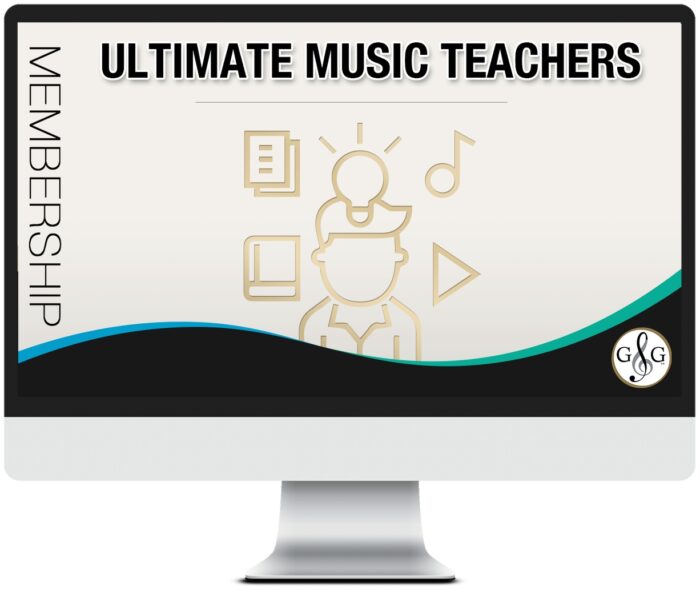
Ultimate Music Teachers Membership
Want Access To The UMT Worksheet That Correlates To This Blog? Get Worksheets, Games, How To Teach Online Tips, Coaching Calls & More!
Accidental Rules - Writing Notes using Accidentals and Key Signatures
Now, what can you do if you made some mistakes and you do not understand the reason why you made the mistakes?
First, re-read this Blog. Read the other Blogs about accidentals. Print off the Worksheets and complete them yourself. Mark them using the corresponding Answer Sheets.
If you are still struggling, remember that I am here for you. You can book me for a 1 hour private Theory Coaching Call. It is so very important to thoroughly understand Theory Concepts so that we can teach them effectively and successfully!
Ultimate Music Teachers Membership
♪ LEARN ♪ PLAN ♪ TEACH ♪ GROW
The One & ONLY Ultimate Music Teachers Membership
To Become A UMT PRO!
Your Success Path Starts Here - Go To TeachUMT.com Today!
Keep on Learning... With a Smile and a Song!
Shelagh McKibbon-U'Ren

